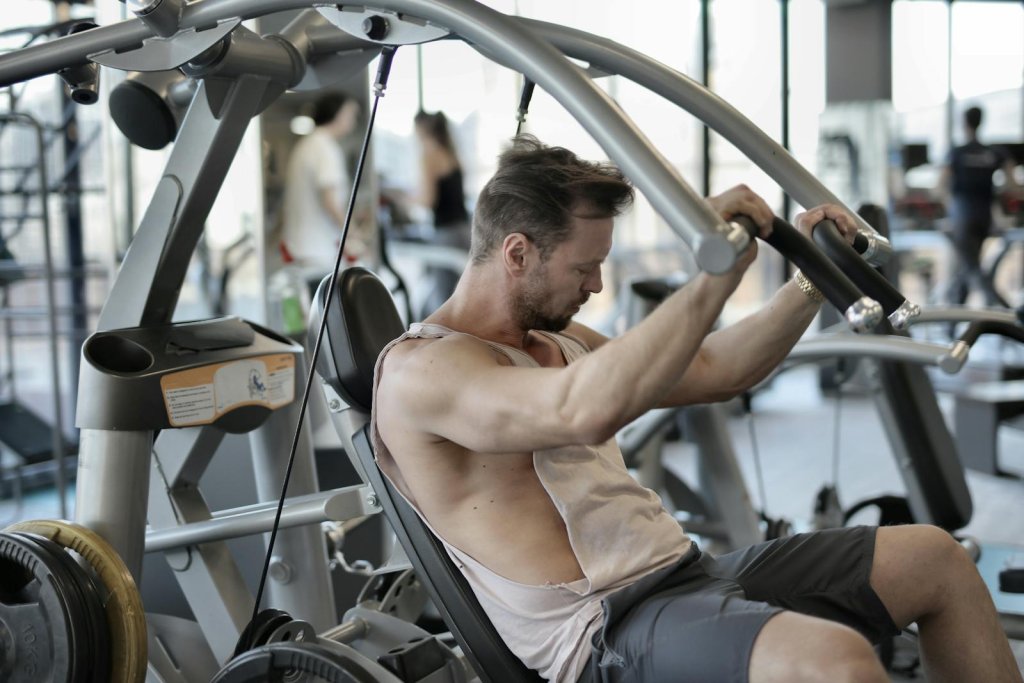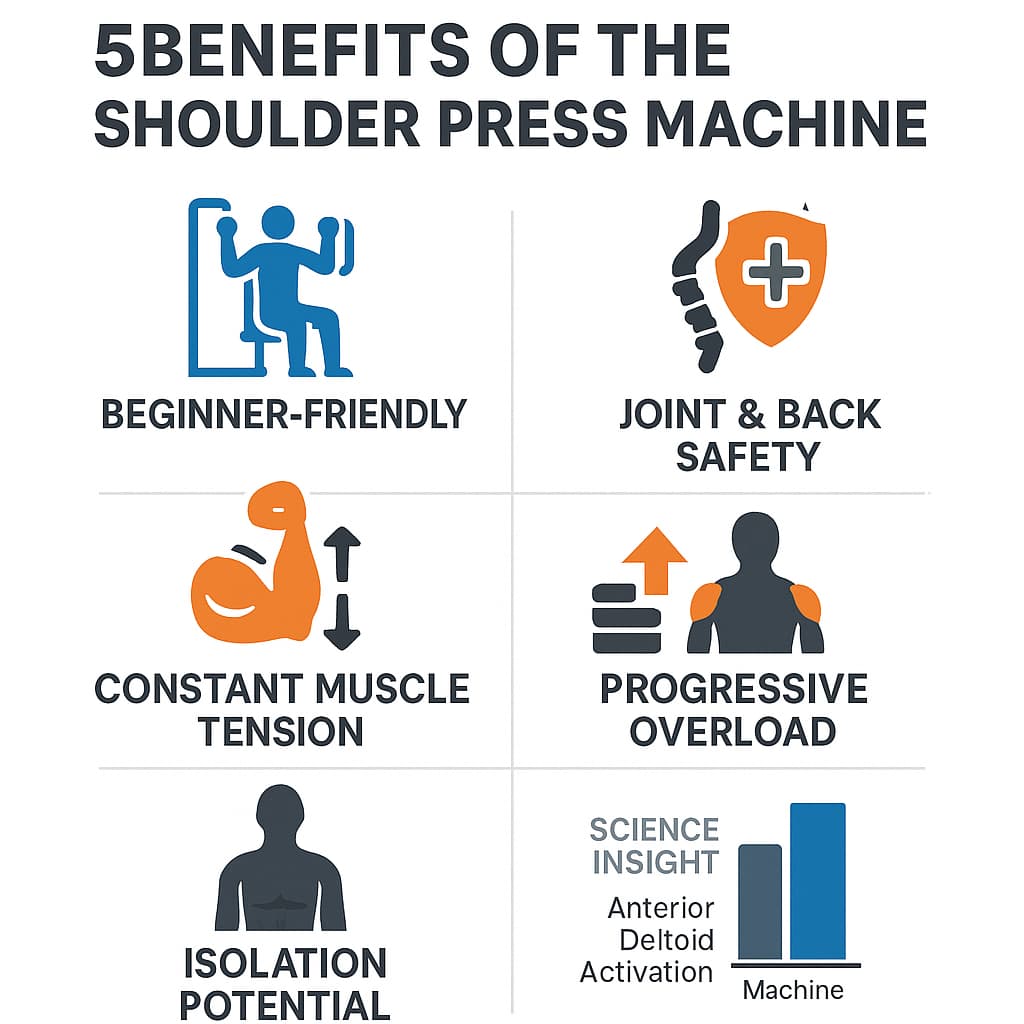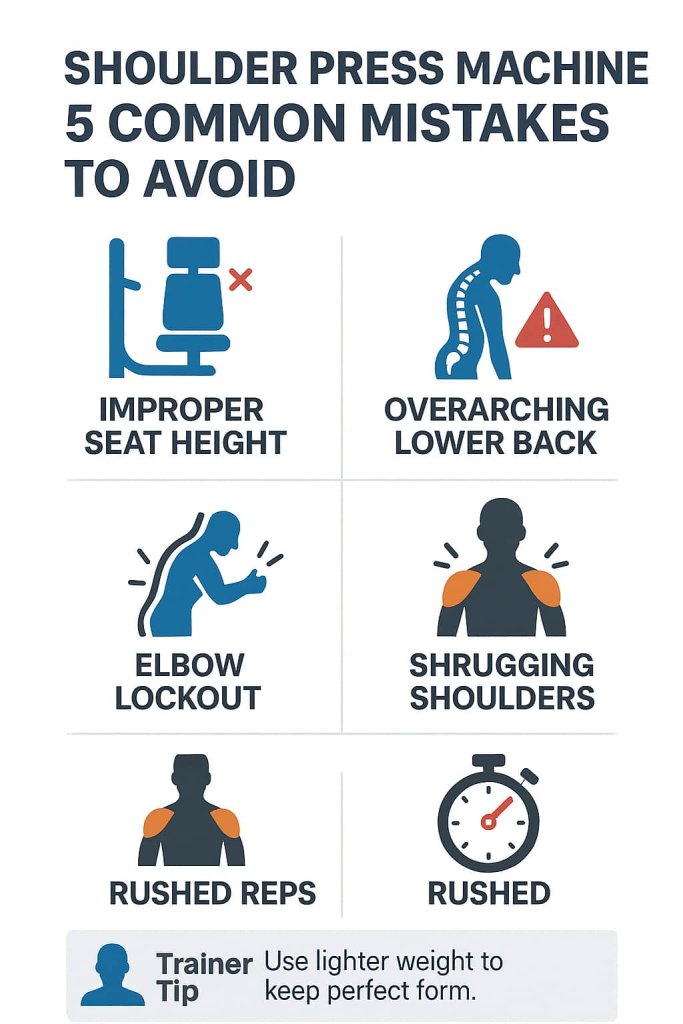The shoulder press machine is one of the most efficient and joint-friendly ways to build bigger, stronger, and broader shoulders.
Unlike free weights, it provides a fixed range of motion, reducing the need for balance and lowering the risk of injury. This makes it ideal for beginners, those recovering from injury, and experienced lifters looking for safe overload.

In this guide, we’ll cover proper form, muscles worked, benefits, common mistakes, alternatives, trainer tips, FAQs, and how to use it in your workout for maximum shoulder growth.
How to Use the Shoulder Press Machine with Perfect Form
Getting your form right on the shoulder press machine is crucial—not just for results, but also for protecting your shoulders and spine.
Step-by-Step Setup
- Adjust the Seat Height
- The handles should be at shoulder height when seated. If they’re too high, you’ll put unnecessary stress on your shoulder joints. Too low, and you’ll shift work to your chest.
- Trainer Tip: Use a mirror or ask a gym buddy to check your alignment.
- Select Your Weight
- Start with 50–60% of your 1-rep max (1RM) to master technique before adding more load.
- For hypertrophy, aim for 8–12 reps per set; for strength, 4–6 reps.
- Body Positioning
- Sit tall with your back, head, and hips firmly against the back pad.
- Feet flat on the ground, slightly wider than hip-width.
- Grip the handles slightly wider than shoulder width with either pronated (palms forward) or neutral (palms facing in) grip.
- The Press
- Exhale and push the handles upward until your arms are almost fully extended—do not lock your elbows.
- Keep your wrists straight and elbows under your wrists for better force transfer.
- The Lowering Phase
- Inhale as you slowly bring the handles back to shoulder height, maintaining tension in your delts.
- Lowering should take about twice as long as pressing up for maximum muscle activation.
Real-World Example:
Research shows that emphasizing a slow, controlled lowering (eccentric) phase in pressing exercises can significantly enhance muscle growth compared to faster, momentum-driven reps.
Muscles Worked
Primary Muscles
- Anterior Deltoid – The front head of the shoulder, responsible for pressing movements.
- Lateral Deltoid – The middle head that contributes to shoulder width.
Secondary Muscles
- Triceps Brachii – Assist during the pressing phase.
- Upper Pectorals – Especially activated with a slight incline seat adjustment.
- Trapezius (Upper) – Stabilizes the shoulder girdle.
- Rotator Cuff Muscles – Stabilize the humeral head during pressing.
Why It Matters:
By focusing on the delts while still engaging assisting muscles, the shoulder press machine helps you build both size and functional pressing strength.
Benefits of the Shoulder Press Machine

- Beginner-Friendly
- The fixed path allows new lifters to focus on building muscle without worrying about balance.
- Joint and Back Safety
- Less strain on the lower back compared to standing barbell presses.
- Constant Muscle Tension
- The machine resists throughout the full range of motion, enhancing hypertrophy.
- Progressive Overload Made Easy
- Just move the weight pin or add plates for consistent progression.
- Isolation Potential
- Allows you to hit shoulders without fatiguing stabilizers too early.
Science Insight:
An EMG study (American Council on Exercise, 2021) found that machine overhead presses activate the anterior delts nearly as much as free weights, but with reduced engagement of the core and stabilizers—making them less fatiguing for accessory muscles.
Common Mistakes to Avoid

- Improper Seat Height – Can shift emphasis to other muscles or strain joints.
- Overarching the Lower Back – A sign you’re using too much weight or lacking core stability.
- Elbow Lockout – Puts excess stress on elbow joints, especially under heavy load.
- Shrugging Shoulders – Engages traps too much and reduces delt activation.
- Rushed Reps – Limits time under tension and reduces growth potential.
Trainer Tip: If you can’t maintain good posture and a controlled pace, reduce the weight until you can.
Alternatives to the Shoulder Press Machine
- Dumbbell Shoulder Press – Builds stabilizer strength and improves mobility.
- Barbell Overhead Press – A compound lift for full-body strength.
- Arnold Press – Rotational pressing for all three delt heads.
- Push Press – Adds explosive power with leg drive.
- Cable Lateral/Front Raises – Isolates individual deltoid heads.
Who Should Use It
- Beginners – Learn pressing mechanics safely.
- Lifters with Shoulder Mobility Issues – Guided path reduces injury risk.
- Bodybuilders – Ideal for isolation work after compound lifts.
- Rehabilitation Clients – With doctor/trainer approval, it’s safer than free-weight presses.
Trainer Tips for Best Results
- Tempo Control: Use a 2–3 second eccentric phase to maximize hypertrophy.
- Volume Guidelines: 3–4 sets, 8–12 reps for size; 4–6 reps for strength.
- Grip Variation: Switch between neutral and pronated grips every few weeks to target different fibers.
- Superset Strategy: Pair with lateral raises for complete shoulder activation.
- Pre-Exhaust Method: Do lateral raises first to fatigue delts before pressing.
FAQs
Q: Is the shoulder press machine better than dumbbells?
A: It’s safer and more stable, making it great for beginners, but dumbbells build more stabilizer strength.
Q: How often should I use it?
A: 1–2 times per week, depending on your program and recovery.
Q: Can it replace the overhead press?
A: Not entirely—use it as a complement to free-weight pressing, not a complete replacement.
Conclusion
The shoulder press machine is a powerful, safe, and efficient tool for building strong, broad shoulders. Its fixed movement path allows you to load the delts heavily without compromising form, making it suitable for beginners, intermediate, and advanced lifters. Combine it with free-weight variations, apply progressive overload, and you’ll see noticeable shoulder gains in both size and strength.e form, avoid common errors, and mix it with other pressing variations for complete shoulder development.
